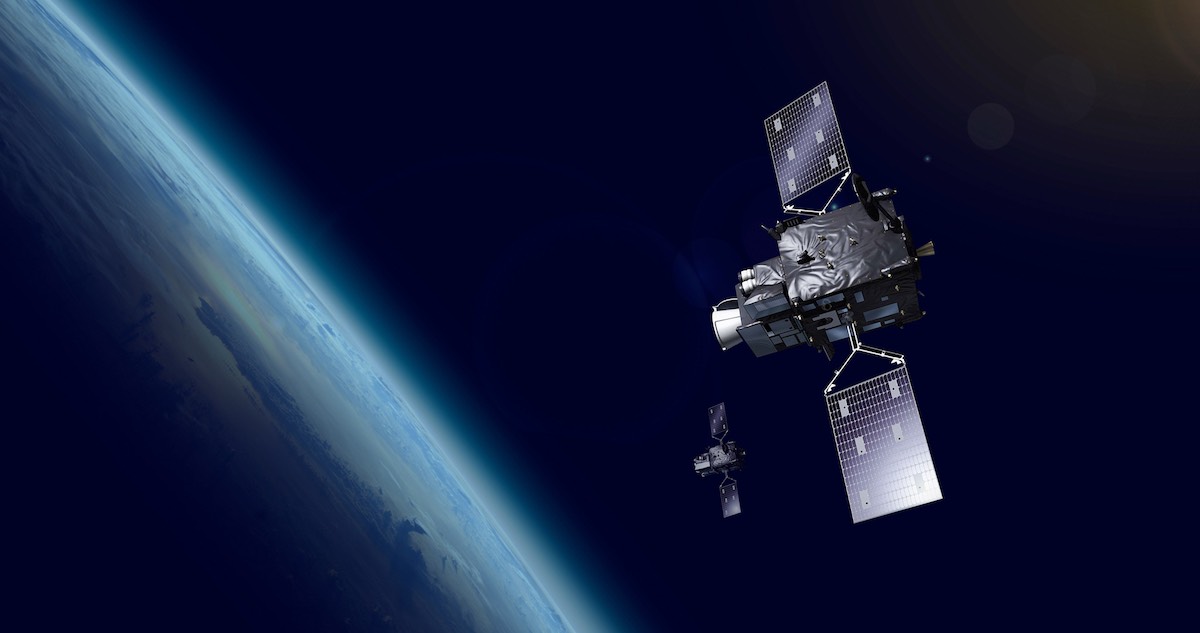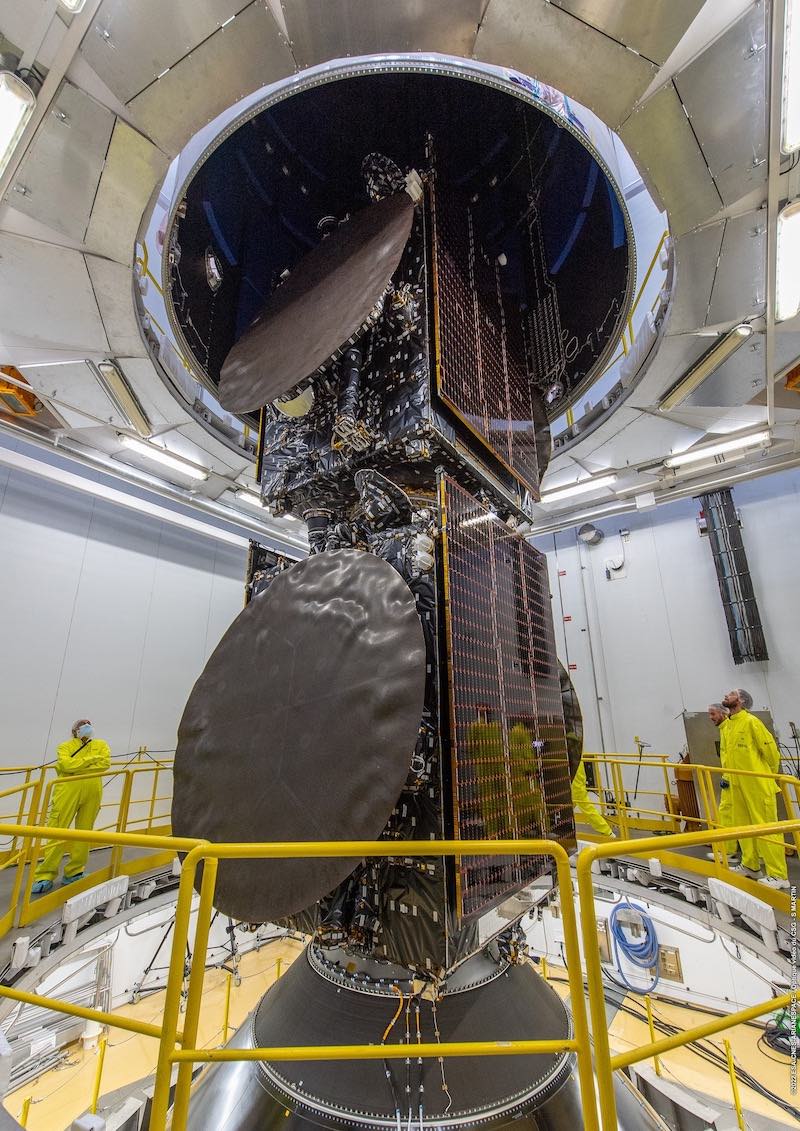
The first in a new generation of European weather satellites is set for launch Tuesday on a mission that promises to improve the timeliness and precision of weather forecasts for Europe and Africa, sharing a ride to space from French Guiana on an Ariane 5 rocket with two Intelsat communications satellites.
The first of six satellites in Europe’s 4.3 billion euro ($4.5 billion) Meteosat Third Generation, or MTG, program will head for a position in geostationary orbit more than 22,000 miles (nearly 36,000 kilometers) over the equator to begin a planned eight-and-a-half-year service life.
The first MTG satellite carries a rapid-scan imaging instrument, a lightning detector, and radios to support search and rescue services. The spacecraft will be renamed Meteosat 12 after it enters service next year, becoming the primary source of satellite weather observations for real-time forecasting in Europe and Africa.
The MTG program is a partnership between the European Space Agency and Eumetsat, Europe’s weather satellite agency with 30 member states. The MTG program will consist of four imaging satellites, known as MTG-I missions, to look at movements of storm systems, weather fronts, and lightning. There will also be two Meteosat Third Generation spacecraft with infrared sounders, called MTG-S missions, to measure temperatures, moisture, and other parameters throughout Earth’s atmosphere.
The satellite set for launch this week is called MTG-I1. Liftoff from the ELA-3 launch zone at the Guiana Space Center in South America is scheduled during a launch window Tuesday opening at 3:30 p.m. EST (2030 GMT) and running until 5:16 p.m. EST (2216 GMT), according to Arianespace, the Ariane 5 rocket’s launch service provider.
The Ariane 5 launcher will haul MTG-I1 and two Intelsat communications satellites — Galaxy 35 and 36 — into an elliptical geostationary transfer orbit ranging more than 22,000 miles above Earth at its highest point.
The rocket will blast off with 2.9 million pounds of thrust from its twin solid-fueled boosters and core stage French-made Vulcain 2 engine, burning liquid hydrogen and liquid oxygen propellants. The two strap-on boosters will burn out and jettison a little more than two minutes into the mission, then the Ariane 5’s Swiss-made nose cone will release to fall into the Atlantic Ocean east of French Guiana.
The upper stage of the Ariane 5, assembled in Germany, will take over the mission about nine minutes into the flight to propel the MTG-I1 and Galaxy 35 and 36 satellites into the proper orbit for deployment.
Galaxy 35 and 36, stacked one on top of the other and built by Maxar in California, will separate from the rocket about 27-and-a-half and 31 minutes after liftoff.

Galaxy 35 and 36 will use their own propulsion systems to reach a circular geostationary orbit over the equator, a process that will take a few weeks. They will enter service early next year to provide C-band television broadcast services over the United States, part of a transition mandated by the Federal Communications Commission to free up a slice of the C-band spectrum for terrestrial 5G broadband connectivity.
The transition to 5G requires satellite operators like Intelsat to build and launch new satellites to maintain their C-band programming for cable TV networks in the United States. The new C-band satellites are designed to operate in a more narrow segment of the C-band spectrum, permitting other frequencies to switch over to 5G services.
The Galaxy 35 and 36 satellites are the fifth and sixth new C-band satellites Intelsat has launched this year. Four new Intelsat C-band spacecraft launched on a pair of SpaceX Falcon 9 rockets earlier this year, and a seventh and final new C-band payload will launch on a SpaceX mission in 2023.
Once the Intelsat satellites separate from the Ariane 5 rocket, the upper stage will release a carbon composite structure covering the MTG-I1 weather satellite, which will deploy from the launcher about 34-and-a-half minutes into the mission.
MTG-I1 will go through a similar series of post-launch maneuvers as Intelsat’s satellites, extend its solar arrays, and settle into geostationary orbit for up to one year of commissioning and testing before officials entrust it to provide crucial data for weather forecasters.
“The MTG program is undoubtedly a European success,” said Phil Evans, director general of Eumetsat. “It’s relied on the expertise of Eumetsat, ESA, and a wide range of European industry in a multibillion-pound project, and is one of the most complex and advanced satellites currently being developed.
“MTG-I, specifically, will focus on the detection of rapidly developing extreme weather events, such as storms, which have the biggest impact on our society,” Evans said in a pre-launch press conference. “It will provide us higher resolution data, better quality data, and in fact, will provide our users with over 50 times more data than is currently available.”
Thales Alenia Space of France led the pan-European contractor team that developed the MTG-I1 satellite. OHB System AG, a Germany company, supplied the satellite structure itself. Thales also developed the Flexible Combined Imager, the MTG-I1 spacecraft’s primary weather sensing payload. The Italian company Leonardo provided the Lightning Imager instrument.

The Meteosat Third Generation satellites will replace Europe’s Meteosat Second Generation, or MSG, satellites that launched from 2002 through 2015. Europe’s first Meteosat weather satellite launched in 1977, and MTG-I1 will be the 12th Meteosat to launch in the program.
The upgrades on the new generation of Meteosat satellite include the Flexible Combined Imager, which will collect and transmit images of rapidly-evolving storms over Europe every two-and-a-half minutes, half the time it takes to take a picture over Europe with the currently operating Meteosat satellites. MTG-I1 will update its view of Africa every 10 minutes, an improvement over the 15-minute imaging cadence now available for that region.
The MTG imaging instrument also has 16 channels in visible and infrared wavelengths, instead of the 12 available on the current satellites, giving it the capability to see more detail in cloud temperatures and structure. And the imager’s resolution is also improved on the Meteosat Third Generation satellites, providing sharper views of clouds and storms.
“I think it’s important to recognize that very, very intense, very localized severe weather — the sort of thing that might affect a village or a town, but is very local — is incredibly hard to forecast,” Evans said. “Even with the best of computers and the best science, it’s still really challenging. The observations from a satellite like this give us a real chance to give people reasonable amounts of warning for the most devastating weather.”
The new generation of European weather satellites will provide more advance warning of thunderstorms, tornadoes, and flooding rainfall. The Meteosat satellites are also used to track wildfires, volcanic ash, and ice clouds in the upper atmosphere that could impact aviation.
“We need better short range forecasts, looking at the next few hours ahead, to help emergency responders to to take the correct kind of action, both to put their resources in place when they need to respond to incident, and also to give them a heads-up when the worst of the weather has passed so they can begin the recovery effort,” said Simon Keogh, head of space applications and nowcasting research and development at the UK Met Office.
The first MTG Sounder satellite is scheduled for launch in late 2024, and a second MTG Imager satellite is slated to blast off in 2026. Two more imaging satellite and one more sounding satellite will launch in the early 2030s to maintain coverage through at least 2040.
“With these satellites coming together, we’ll be able to monitor, for the first time, the atmospheric conditions, which are the precursor to a severe weather event, severe weather events rising actually as they occur, and the most intense places through the lightning images,” Evans said.

Eumetsat provided most of the funding for the six-satellite MTG program, paying for the design of the overall system, launch services, operations, and data exploitation. ESA managed the procurement of the satellites.
“It has taken longer than we hoped,” said Paul Blythe, ESA’s Meteosat program manager. “When you’re developing these technologies, we get surprises. By definition, if we are pushing the edge, sometimes the edge bites us, and we’ve had two or three developments, particularly on optical coatings, we had some challenges, and on detectors, we had some challenges.”
The Meteosat satellites are similar to NOAA’s GOES weather satellites that cover the Americas, and Japan’s Himawari geostationary observatories over the Asia-Pacific region.
The launch Tuesday will mark the third-to-last flight of Europe’s workhorse Ariane 5 launch vehicle. Two more Ariane 5s are left to fly in 2023 before the transition to the next-generation Ariane 6 rocket.
Email the author.
Follow Stephen Clark on Twitter: @StephenClark1.
from Spaceflight Now https://ift.tt/fG4vw10
via World Space Info







0 comments:
Post a Comment